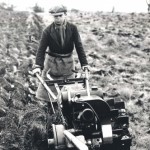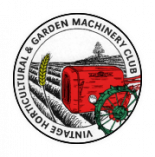Forum Replies Created
-
AuthorPosts
-
November 6, 2016 at 7:23 pm #22891
 trusty220Keymaster
trusty220KeymasterThe copper washer should be free to rotate around the crankshaft so that it doesn’t transfer the drive from the clutch carrier to the drum. The key should not protrude from the back of the clutch carrier.
November 5, 2016 at 6:49 pm #22849 trusty220Keymaster
trusty220KeymasterIt looks like someone has modified it at some point, as the normal key for this fitting is one with a grease nipple in the end and the key itself is drilled to pass the grease to the bush. The engine crankshaft is not normally drilled like yours, so it possibly has been a problem for the previous owner(s). From the first picture it does look like there’s a large gap between the bush and the crankshaft which will allow the drum to “pick up” every now and again, and no amount of greasing will correct it. It may be that you need to replace the bush- take the dimensions for the inside diameter, outside diameter and length of bush to any bearing supplier and they should be able to sort you out. Some suppliers only stock metric these days, so you may have to search around for one that sells imperial sizes.
Of course, you may be right with your first guess that someone has pushed the key in too far and it is causing the drum to rotate with the clutch. Just pull the key out a little to test the theory.
Wristpin is correct in his copper grease comment. After a short while it does tend to dry out and cause things to stick together that should slip. Best to stick to normal LM grease- that’s what it was designed for after all.
Best of luck.
November 2, 2016 at 5:18 pm #22825 trusty220Keymaster
trusty220KeymasterThat sounds quite straightforward, then. Best of luck with the project.
November 2, 2016 at 9:36 am #22824 trusty220Keymaster
trusty220KeymasterIt appears that we’ve been moved this year from Crocker Hall 2 to Hall 1, which is only next door and is considerably warmer!
I haven’t had confirmation for the club stand yet, so I’m only guessing that it will be in Hall 1 with the exhibits.November 2, 2016 at 9:33 am #22823 trusty220Keymaster
trusty220KeymasterThe bush in question is normally a phosphor bronze one. When they become worn they can wobble about on the crankshaft and pick up drive intermittently. The best solution is to replace it, although lubricating it through the crankshaft key can have good results as well.
October 27, 2016 at 7:52 am #22770 trusty220Keymaster
trusty220Keymaster……..and also on later JAP 5’s at least!
October 25, 2016 at 4:39 pm #22767 trusty220Keymaster
trusty220KeymasterJust check what type of fitting you have- does it fit on a flat platform with three holes in or does it clamp on a flange around the drive dog? Those are basically the two variations that it may be with the numbers quoted.
Best of luck with it.
October 21, 2016 at 7:56 am #22739 trusty220Keymaster
trusty220KeymasterI’ve just had a brain wave after the last posting I made. The JAP 5’s and 6’s had two styles of magneto fitted depending on how old they are; the older ones that I have on my Trusty tractors are fitted to a horizontal platform cast into the crankcase, and three bolts secure it from underneath. The later type that seem to have been fitted from the 1960’s onwards are mounted on a vertical flange around the drive coupling with two studs that stick out from the crankcase.
That would probably account for the difference in part numbers for the body of the magneto.
October 20, 2016 at 6:34 pm #22737 trusty220Keymaster
trusty220KeymasterFor the JAP Model 4/2, 5 and 6 the correct magneto is the A-576BZ.
The A-936BZ that you mention seems to have many common parts with the A-576BZ but the main housing is listed as a different part number. What the difference is I don’t know, and both are stated as having a counter-clockwise rotation so it may fit.
October 19, 2016 at 7:59 am #22724 trusty220Keymaster
trusty220KeymasterThe correct engine (if it’s a JAP) should be a JAP 600 which is an adapted motorcycle engine with a circular crankcase and dry sump. Some were also fitted to later Trusty Steeds.
You are quite right in assuming that the engine you have is either a JAP 5 or 6. The serial number will be on the top of the crankcase above the output shaft. I’ll look up the type of WICO A magneto that you need to get it going and post later.
October 14, 2016 at 4:37 pm #22711 trusty220Keymaster
trusty220KeymasterYes I did, but I’ve been a little busy the last few days so I’ll deal with it over the weekend.
Have a good holiday.
October 13, 2016 at 6:30 pm #22707 trusty220Keymaster
trusty220KeymasterAlso, make sure that the clutch shoes are fitted in the trailing position rather than leading. If they are in the leading position they will drive well but will not disengage because they naturally pull themselves into engagement.
Clutch shoes fitted in the trailing position don’t naturally bite and so disengage more freely. This applies to all centrifugal clutches, not just the Trusty ones.
October 10, 2016 at 4:25 pm #22691 trusty220Keymaster
trusty220KeymasterThat’s a nice, straight and original single speed Trusty. The slot in the side of the left hand handlebar is for the brake lever rod- when the Safety Reverse was fitted (an optional extra) the lever to engage the reverse gear fitted underneath the left hand handlebar in the position that the brake lever was normally fitted, so the brake lever was re-positioned to the side of the handlebar and it’s actuating rod went inside the tube through the slot.
Many of the single speed tractors from the late 40’s were neither fitted with a brake or a Safety Reverse but still appeared with a slot in the side of the handlebar. It appears that a whole batch was made like this, so please don’t go searching for gearboxes or brakes because the probability is that it was never fitted with either.
Did you ever get the dog clutches to engage smoothly? Trusty clutch springs are available from the club shop if you need them.
October 10, 2016 at 9:43 am #22686 trusty220Keymaster
trusty220KeymasterCould you post a side view of the Trusty to give us a better idea of the tractor. If you send me a pm with the serial number I will amend the Trusty Register and let you know what I can about it.
Geoff Ravenhall
October 10, 2016 at 9:39 am #22685 trusty220Keymaster
trusty220KeymasterWithin reason, any engine oil will do. It is there so that the air sucked in has to bubble through it and any dust that is present in the air then sticks to the oil. Once in a while it is worth removing the bath off the bottom and cleaning it out in petrol to get rid of the muck that settles to the bottom (you’d be surprised how much it traps), and it is also worthwhile soaking the whole air filter body and flushing it through to remove any dirt build up that is in the mesh.
From time to time the carburettor will flood, particularly when cold starting, and this excess petrol will find it’s way into the oil bath in the air filter. Don’t worry about this it is perfectly normal and doesn’t affect how the engine runs unless the level of the liquid goes above the mark on the oil bath. Just tip a bit out to return the oil to the correct level, a little petrol dilution won’t cause any harm.
-
AuthorPosts
